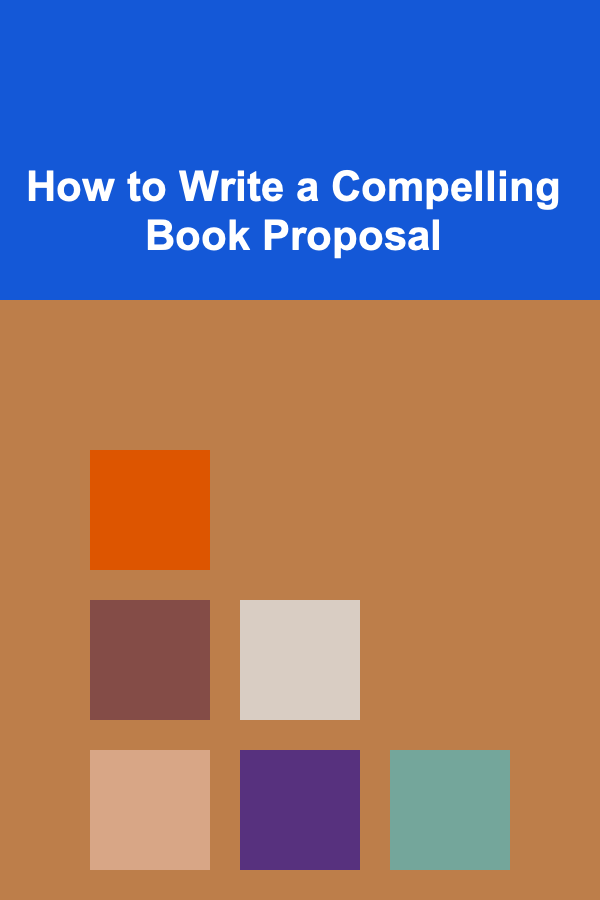
How to Write a Compelling Book Proposal
ebook include PDF & Audio bundle (Micro Guide)
$12.99$8.99
Limited Time Offer! Order within the next:

Writing a book is often considered a monumental achievement, but getting that book published is an entirely different challenge. One of the key steps in this process is creating a book proposal. A book proposal is a document that provides potential publishers with an overview of your manuscript, your target audience, and why your book is worth publishing. It's a vital tool for any author, particularly those seeking traditional publishing deals, as it serves as the initial pitch to publishers, agents, or editors.
In this guide, we'll explore how to write a compelling book proposal that grabs the attention of publishers and increases your chances of success. Whether you're a first-time author or a seasoned writer, mastering the art of the book proposal is essential for navigating the competitive world of publishing.
What Is a Book Proposal?
A book proposal is a marketing document that outlines your book and its potential in the marketplace. Unlike a manuscript, which presents the complete text of your book, a proposal is a business pitch. It explains your book's concept, why it matters, and how it fits into the larger market. It provides details about you as an author, your target audience, and your marketing strategy. A well-written book proposal demonstrates that there is demand for your book and that you, as the author, have the necessary skills and resources to make it a success.
A book proposal is often submitted to literary agents, publishers, or editors before submitting the actual manuscript, especially for nonfiction books. The proposal serves as a way to sell your idea and convince the publisher that it's worth investing in your book.
Key Components of a Compelling Book Proposal
A compelling book proposal should be clear, concise, and persuasive. It needs to present your book idea in a way that demonstrates its marketability while also showing that you have a clear understanding of the writing and publishing process. While the structure and specific content of a book proposal can vary depending on the genre and publisher's requirements, there are certain key elements that should be included in any proposal.
1. Book Overview
The book overview is the first section of your proposal, and it's your chance to make a strong first impression. This section should be succinct yet informative, outlining the essence of your book and why it matters.
In this section, you should answer the following questions:
- What is your book about? (Brief description)
- What makes your book unique or different from other books in the genre?
- What is the primary theme or message of the book?
Think of this as the elevator pitch of your book, where you must convey the most important aspects of your project in a few short paragraphs. If you're writing nonfiction, make sure to explain why your topic is timely and relevant. For fiction writers, explain what makes your story compelling and how it will captivate readers.
2. Target Audience
Publishers and agents need to know who will buy your book, so this section is crucial in demonstrating the commercial potential of your project. You should define the audience your book is meant for and give evidence that this audience exists and is likely to respond positively to your book.
Key points to address:
- Who is your target reader? (Age, gender, interests, demographics)
- What is the size of your target market?
- What are the habits of your target audience? (Where do they shop for books? What are their reading preferences?)
- What other books are similar to yours, and why will your book appeal to the same audience?
Providing evidence of your target audience will make your book proposal more persuasive. Publishers want to know that there is a ready market for your book, so if possible, include data about the demand for books in your genre, trends, and statistics that support your argument.
3. Competitive Analysis
Publishers want to know how your book compares to others in the marketplace. This section, also known as the "comps" section, involves identifying similar books to yours and demonstrating why your book will stand out in the market.
In this section, you should:
- Identify 3-5 books that are similar to yours, in terms of genre, subject matter, or tone.
- Explain why your book is different from or better than those books.
- Provide details on the success of those books, such as their sales figures, popularity, or critical reception.
A solid competitive analysis will show that you are aware of the current market and how your book fits within it. It also gives the publisher a sense of how your book might perform, based on the performance of similar works.
4. Marketing and Promotion Strategy
Publishers want to know how you plan to promote your book. While they will likely handle much of the marketing, they will expect you, as the author, to be an active participant in promoting your work. A well-thought-out marketing plan demonstrates that you are serious about your book and prepared to put in the effort to make it successful.
In this section, consider the following:
- Do you have an established platform (e.g., a blog, social media following, podcast, etc.) that you can use to promote the book?
- Have you identified any key influencers, organizations, or media outlets that can help you publicize the book?
- Are you willing to go on book tours, attend events, or participate in interviews to promote your book?
- Do you have connections in the industry, such as other authors, bloggers, or journalists, who could support your book?
A comprehensive marketing strategy will show that you understand the importance of promotion in the success of your book. Even if you don't have a large platform yet, being creative and proactive in your marketing efforts can demonstrate your commitment.
5. Author Bio
The author bio section gives the publisher insight into who you are and why you're the best person to write this book. This section should highlight your credentials, writing experience, and any relevant expertise or background that positions you as an authority on the subject.
Key points to address:
- What is your professional background and writing experience?
- Do you have any specialized knowledge, credentials, or expertise relevant to the book?
- Have you published other works or articles?
- What is your platform, and how can you connect with your target audience?
The more credible and authoritative you appear in your bio, the more likely publishers will take you seriously. If you don't have significant publishing experience, focus on any unique perspectives, stories, or expertise that make you the ideal author for this project.
6. Outline and Sample Chapters
For nonfiction books, you will likely need to provide a detailed outline that breaks down the structure of your book. This will show the publisher that you have a clear vision for the entire book, and you can demonstrate how you plan to present the content in a logical, coherent manner.
For fiction books, provide a synopsis or brief summary of the plot. You should also include sample chapters (usually the first three chapters or so) that demonstrate your writing style and the tone of the book.
Make sure the outline and sample chapters are polished and well-written, as they are critical to showcasing your ability to finish the book and the potential of the manuscript.
7. Chapter Breakdown (for Nonfiction)
If your book is nonfiction, it's important to provide a detailed chapter breakdown in your proposal. This allows the publisher to get a sense of how your book will unfold and the key points you will address in each chapter.
Your chapter breakdown should include:
- The title and focus of each chapter
- A brief description of what will be covered in each chapter
- How each chapter contributes to the overall theme of the book
A detailed breakdown of chapters will demonstrate that you have thought deeply about your book's structure and content.
Writing Tips for a Successful Book Proposal
Now that you know the key components of a book proposal, here are a few writing tips to help you create a proposal that stands out:
1. Be Clear and Concise
A book proposal is a business document, so it's important to get to the point. Publishers and agents are busy, so they don't have time to read lengthy, meandering proposals. Keep your proposal clear, concise, and well-organized.
2. Tailor Your Proposal
Every publisher or agent has different requirements, so make sure to tailor your proposal to their specific guidelines. Research the publisher's catalog to understand their focus and the types of books they publish. This will help you craft a proposal that aligns with their needs.
3. Show Your Passion
Even though a book proposal is a business pitch, it's also an opportunity to show your passion for the project. Let your enthusiasm for your book shine through in your writing, and make it clear why you are the best person to write this book.
4. Be Professional
A book proposal is a formal document, so make sure it's professionally written, well-edited, and free of errors. This is your first chance to impress a potential publisher, so ensure your proposal reflects your commitment to quality.
Conclusion
Writing a compelling book proposal is a critical step in getting your book published, especially in the traditional publishing world. A well-crafted proposal will not only help you secure a publisher but will also help you clarify your book's goals, structure, and target audience. By focusing on the key components---book overview, target audience, competitive analysis, marketing strategy, author bio, and sample chapters---you can create a persuasive proposal that sets you up for success. With the right proposal in hand, you'll be one step closer to bringing your book to the world.
Reading More From Our Other Websites
- [Personal Investment 101] How to Invest in Technology Stocks for Maximum Growth
- [Home Maintenance 101] How to Organize Your Appliance Manuals and Warranties
- [Home Family Activity 101] How to Plan a Family Movie Marathon
- [Whitewater Rafting Tip 101] Top 10 High-Performance Rafting Boats for Adventure Seekers
- [Organization Tip 101] Jigsaw vs. Circular Saw: Safety Tips and Best Practices
- [Home Holiday Decoration 101] How to Make DIY Christmas Ornaments to Personalize Your Tree
- [Home Staging 101] How to Highlight a Home's Features When Staging an Older, Charming Property
- [Home Pet Care 101] How to Create a Safe and Enjoyable Outdoor Space for Your Pets
- [Personal Care Tips 101] How to Layer Hair Gel with Other Hair Products for a Complete Style
- [Stamp Making Tip 101] Troubleshooting Common Ink Issues: Fading, Bleeding, and Drying Time

How to Manage Multiple Projects While Working Remotely
Read More
How to Manage Sensitive Files with Encryption
Read More
How to Stage Your Home for Maximum Light and Brightness
Read More
How to Write Meaningful Letters for Future Generations
Read More
How to Create Compelling Game Characters with Limited Resources
Read More
10 Tips for Maintaining Work-Life Balance as a Scientist
Read MoreOther Products

How to Manage Multiple Projects While Working Remotely
Read More
How to Manage Sensitive Files with Encryption
Read More
How to Stage Your Home for Maximum Light and Brightness
Read More
How to Write Meaningful Letters for Future Generations
Read More
How to Create Compelling Game Characters with Limited Resources
Read More